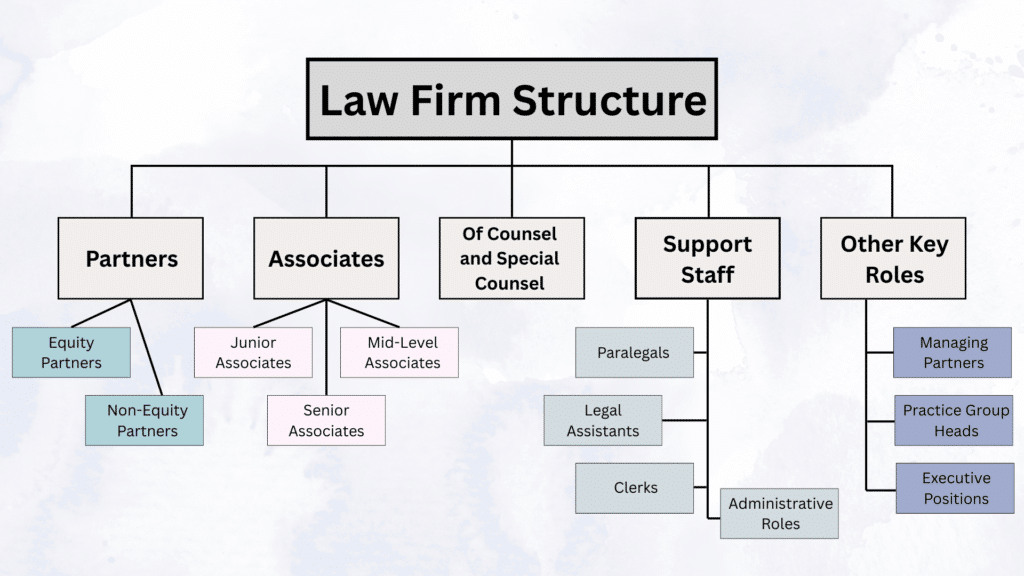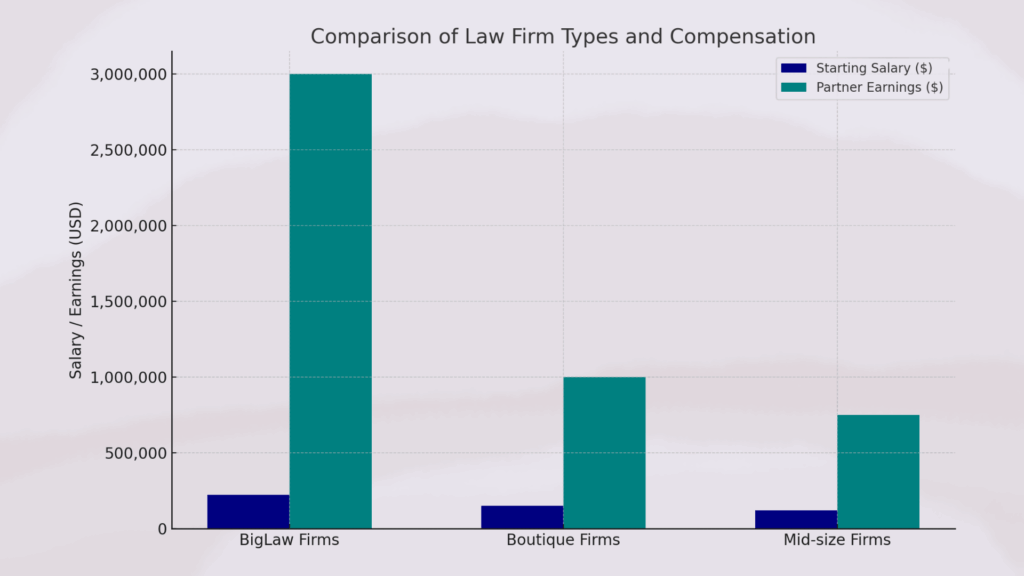For legal professionals and job seekers, understanding the structure of law firms is essential for career planning and workplace success.
The legal industry operates with clear organizational levels that determine responsibilities, compensation, and advancement opportunities.
This comprehensive overview examines the typical roles, structures, and compensation at leading law firms across the United States.
Understanding these dynamics helps professionals make informed decisions about their legal careers.
What is Hierarchy in a Law Firm?
Law firm hierarchy refers to the organizational structure that establishes clear levels of authority, responsibility, and decision-making power within legal practices.
This system creates defined career paths and determines how lawyers progress from entry-level positions to senior leadership roles.
The hierarchical structure serves multiple purposes:
- It establishes clear reporting relationships,
- defines compensation levels,
- determines client responsibilities,
- and creates pathways for professional advancement.
Authority flows from senior partners down through various levels of attorneys and support staff.
Law Firm Hierarchy Structure

For your reference, here is the law firm hierarchy chart template, which you can refer to for a better understanding of the law firm hierarchy in the USA.
Law firms operate with distinct organizational levels, each carrying specific responsibilities and advancement opportunities that shape legal careers from entry-level positions to senior leadership roles.
1. Partners
Partners represent the senior leadership of law firms, divided into ownership and non-ownership tracks with distinct compensation structures.
- Equity Partners represent firm ownership, investing capital, and receiving profit distributions. They make strategic decisions, vote on policies, and typically earn the highest compensation.
- Non-Equity Partners hold senior positions with major client responsibilities but receive fixed salaries plus bonuses instead of profit shares.
Both partner types manage client relationships, oversee case strategy, mentor attorneys, and generate business for the firm.
2. Associates
Associates form the backbone of law firms, progressing through three levels with increasing responsibility and independence over their careers.
- Junior Associates join firms from law school, working under supervision on research, document drafting, and case support. They typically have 1-3 years of experience.
- Mid-Level Associates handle complex responsibilities, manage smaller cases independently, and supervise junior staff. This level includes attorneys with 4-6 years of experience.
- Senior Associates manage significant cases and client interactions while preparing for partnership consideration. They have 7-10 years of experience and specialize in specific practice areas.
3. Of Counsel and Special Counsel
These alternative senior positions provide flexibility for experienced attorneys who bring specialized expertise without following the traditional partnership track.
These positions accommodate senior attorneys with valuable expertise who are not on the partnership track.
Of Counsel may be former partners or specialists, while Special Counsel typically have technical expertise and prefer focused work without business development demands.
4. Support Staff
Non-attorney professionals provide essential operational and administrative support that enables attorneys to focus on legal work and client service.
- Paralegals assist with case preparation, document review, and client communication, often specializing in specific practice areas.
- Legal Assistants handle administrative tasks, scheduling, and document preparation to support attorney productivity.
- Clerks are typically law students or graduates providing research and document review, often as entry points to attorney positions.
- Administrative Roles include HR, accounting, marketing, IT, and facilities management, supporting firm operations.
5. Other Key Roles
In the law firm hierarchy USA, Leadership and executive positions combine legal expertise with business management responsibilities to oversee the firm’s strategy and operations.
- Managing Partner of the law firm oversees operations, strategic planning, and business development while continuing legal practice.
- Practice Group Heads lead specific areas like litigation or corporate law, coordinating attorneys and developing practice strategies.
- Executive Positions include C-suite roles focusing on business operations rather than legal practice.
What Is the Highest Lawyer Rank?
The highest lawyer rank varies: in law firms it’s the Managing Partner, in courts it’s KC/QC or Senior Advocate, and in government it’s the Attorney General leading legal affairs.
Highest Paying and Leading Law Firms 2025

The legal market includes several categories of firms with different compensation structures and career opportunities.
BigLaw Firms are the largest and most prestigious practices, employing hundreds or thousands of attorneys across multiple offices.
Examples include Cravath, Sullivan & Cromwell, and Skadden. They offer the highest starting salaries at $215,000-$230,000 for first-year associates, with partner compensation reaching millions annually.
Boutique Firms specialize in specific practice areas with fewer attorneys. While salaries may be lower than BigLaw, successful partners can achieve significant earnings through specialized expertise.
Mid-size firms provide a balance between large firm resources and smaller firm culture, with varied compensation but potentially better work-life balance.
Average Lawyer Compensation Range in 2025
Compensation at top-tier law firms varies significantly by position and experience level in the law firm hierarchy USA, with substantial increases at each hierarchical stage.
| Position | Annual Compensation |
|---|---|
| First-year associates | $215,000-$230,000 plus bonuses |
| Mid-level associates | $300,000-$400,000 total compensation |
| Senior associates | $400,000-$500,000+ total compensation |
| Non-equity partners | $500,000-$1,000,000+ annually |
| Equity partners | $1,000,000-$5,000,000+ annually |
These ranges vary significantly based on firm size, location, practice area, and individual performance.
How Hierarchy Impacts Career Growth?
Understanding how firm hierarchy affects professional development helps attorneys plan their careers and meet advancement expectations at each level.
1. Mentorship and Learning Opportunities
Each level offers unique learning experiences.
- Junior associates develop fundamental skills under close supervision.
- Mid-level associates gain case management and client interaction experience.
- Senior associates focus on business relationships and leadership skills needed for partnership.
2. Promotion Timelines and Criteria
Most firms follow predictable advancement schedules with annual promotions for early-career associates.
Senior associate promotion typically occurs around years 6-8, with partnership consideration beginning after 8-10 years.
Success requires demonstrating legal competency, client development skills, and firm leadership.
3. Performance, Business Development, and Specialization
Career advancement demands more than legal expertise.
Associates must build client relationships, develop specialized knowledge, and contribute to business development.
Partnership requires proven ability to attract and retain clients through industry expertise and professional networks.
Conclusion
Understanding the law firm hierarchy is essential for making informed career decisions and setting realistic expectations for advancement.
Success requires more than legal expertise. It demands relationship-building skills, business acumen, and long-term commitment to professional growth.
By recognizing the hierarchy and compensation structure, you can chart a clear path forward and position yourself for long-term success in the legal profession.
Ready to excel in your legal career?
Start by identifying which firm structure aligns with your goals and begin building the skills needed for your next promotion.
Frequently Asked Questions
Can Attorneys Switch Between Firms During Their Careers?
Yes, lateral moves between BigLaw, boutique, and mid-size firms are common. Timing and seniority affect compensation and partnership prospects, with specialized expertise improving transition opportunities.
What Happens to Attorneys Who Don’t Make Partner?
Non-partner attorneys have many successful alternatives, including senior associate roles, in-house positions, government work, solo practice, or business and consulting careers.
How Do International Law Firms Differ in Hierarchy from U.S. Firms?
International firms may use different titles like “solicitor” and “barrister” or have regional compensation variations, but the basic associate-to-partner structure remains similar globally.










